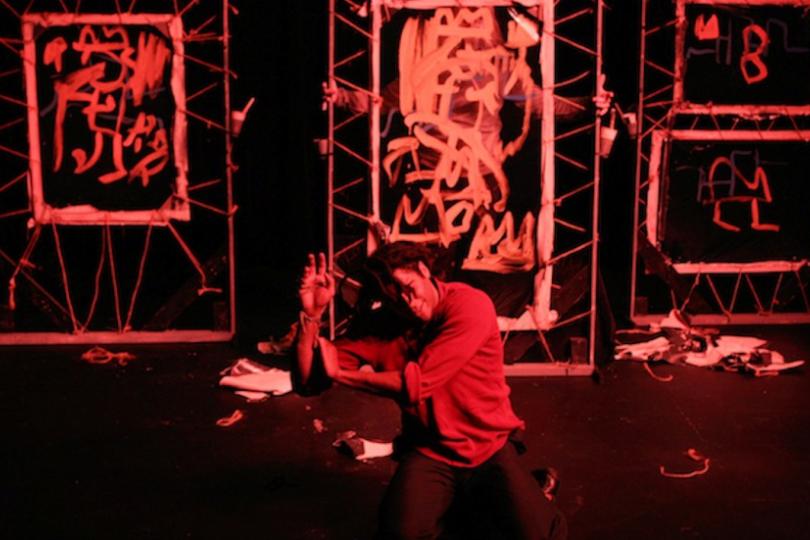Perhaps a residential garage in South Minneapolis in late January of 2015 isn’t quite as far as you can get from the graffiti-tagged alleys and painfully hip art galleries of early 1980s New York City, but it’s quite a ways off nevertheless. And yet it’s tough to think of a more ideal setting for an Off-Leash Area production exploring the art and artifice of Jean-Michel Basquiat. As Paul Herwig explains in the preamble to SAMO: Like a Fiery Comet Jean-Michel Basquiat Shoots Across the Sky, the piece digs into the myths and contradictions of a savvy, driven kid from a middle-class Haitian-Puerto Rican family gaining fame as the hardscrabble, “primitive” voice of the African-American mean streets. Basquiat’s brief career was marked by facades, distortions and misrepresentations both intentional and otherwise. In that light, presenting SAMO in Off-Leash’s unassuming garage/performance space makes all the sense in the world.
Capturing a well-known historical figure is a particularly tricky acting feat, and the challenge is doubled when there’s already a “definitive” portrayal in the canon (in this case, Jeffrey Wright’s excellent lead turn in Julian Schnabel’s frustrating yet fascinating biopic Basquiat). Fortunately, SAMO doesn’t task Brian Evans with playing Basquiat The Man so much as Basquiat The Concept. It’s a thrilling performance, intensely physical but also deeply emotional. Evans, who also choreographed, makes full use of the small stage, boxing shadows, vaulting obstacles, slathering himself in paint and speedily creating and destroying facsimiles of Basquiat’s artwork in real time. The role requires hairpin turns from rage to elation, swagger to ennui, callousness to tenderness, and Evans never falters.
A white man in whiteface
The show would be recommendable on the strength of Evans’ performance alone, but there’s more to it than that. The program credits Paul Herwig’s character as Death, but that’s a blanket term for a host of Basquiat satellites who contributed to his eventual downfall. Slathered in white makeup and sporting a rotation of descriptive nameplates (“Critic,” “Girlfriend,” “Warhol,” etc.), Herwig constantly circles the stage, abetting, taunting and exploiting the artist at equal turns. It sounds a little on-the-nose on paper, but in practice he cuts an eerie, intense figure who both educates and implicates the audience in Basquiat’s rise and collapse. It’s no accident that the play’s most pervasive and invasive figure is played by a white man in whiteface.
And speaking of white faces, that’s another area where SAMO functions as a metaphor for itself. Obviously a theater doesn’t dictate who comes to its shows, but a Sunday night crowd composed of nine well-dressed Caucasians is marvelously apropos for a production largely about an enigmatic artist of color being packaged and marketed to a worldwide audience of well-dressed Caucasians.
That’s part of the reason it’s hard to picture SAMO being as effective in a larger space. While it isn’t participatory theater, it’s a production that feeds off the intimacy of a small audience in close quarters. Being able to read the joy, fear and weariness on Evans’ face is crucial to the show’s impact. The crowd, likewise, is made to feel alternately like artistic collaborators and crass voyeurs simultaneously building and trampling a legacy. When Herwig finally brings down the bars on Evans’ cage, it’s vital that the crowd feels just as cut off and compartmentalized as does Basquiat. That’s an effect you’d be hard-pressed to replicate in a roomy auditorium with stadium seating. For a show like this, you just can’t beat a chilly garage in South Minneapolis.
The living death of commodification
As beautifully as SAMO works as a performance, it also holds its own as commentary. Right from the show’s first moments, when Herwig and Evans talk over each other in warring exposition about Basquiat’s life and work, the theme of art being molded and distorted by external forces resonates intensely. Looking beyond Basquiat, SAMO is also an examination of the phenomenon a recent piece in The Atlantic described as “the death of the artist and the birth of the creative entrepreneur.” Throughout the narrative, it’s never entirely clear how much of a willing participant Basquiat is in his own exploitation. For all the sideshow barking of Herwig’s parade of profiteers, there’s no question that the artist is reaping a windfall of his own and at least partially relishing the notoriety. Whether that makes him any less of a tragic figure is up to the viewer to decide.
He certainly looks heroic in SAMO’s striking closing scene, when all of the users and enablers peel away to leave Basquiat alone with Death, standing tall amidst the hanging skeletons of his own heroes. Some of those idols - Jimi Hendrix, Charlie Parker, Janis Joplin - took the same “better to burn out” path that Basquiat did, but it’s worth noting that some of the corpses on stage - William S. Burroughs, Sugar Ray Leonard - outlived their acolyte. That may be the morbid final message of SAMO: once the artist becomes an icon, actual creation becomes secondary to the living death of commodification. A cheerful thesis it isn’t, but it’s a powerful piece that demands to be seen.
Ira Brooker
Ira Brooker is a writer and editor residing in Saint Paul's scenic Midway neighborhood. He holds down a corporate job by day and does freelance and creative work at night. He is a former editor of
Minnesota Playlist and has been published in a number of venues both local and national, several of which you may have even heard of. He occasionally prattles on about pop culture at
A Talent For Idleness and maintains an archive at
irabrooker.com.





